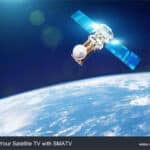In an era dominated by digital streaming services and online content platforms, satellite television continues to maintain a significant presence in the global media landscape. Despite facing new challenges, satellite TV retains a stable market share and continues to serve diverse user groups worldwide. In this article, we’ll delve into the current status of satellite TV, analyzing its market position, user demographics, technological advantages, and the challenges it faces in the digital age.
Satellite Television Market Position:
Despite increasing competition from streaming services, satellite television continues to hold a significant position in the media market, with a considerable market share, especially in areas where internet infrastructure is limited or terrestrial broadcasting is impractical. Its ability to provide consistent programming to remote or rural areas, where digital infrastructure access is uneven, gives satellite TV a competitive advantage. Here are several key advantages of satellite television:
- Extensive Coverage: Satellite TV transmits programs via satellite signals, reaching remote areas beyond the reach of terrestrial broadcasting and areas with underdeveloped internet infrastructure. This allows satellite TV to offer consistent service globally, ensuring viewers in both urban and rural areas can enjoy relatively stable program viewing experiences.
- Diverse Content Selection: Satellite TV offers a wide range of programming covering various genres, including news, sports, movies, and entertainment. Users can choose channels and packages to subscribe to based on their interests and needs, thus customizing their viewing experience.
- Technological Stability and Signal Reliability: Compared to other transmission methods, satellite TV signal transmission boasts high stability and reliability. Even in adverse weather conditions such as storms or blizzards, satellite TV signals typically remain relatively stable, with minimal disruption.
- Global Coverage and International Audience: Satellite TV transcends borders, covering regions worldwide, thereby meeting the demand of international audiences for programming from beyond their own countries. Many satellite TV providers also offer programs and services in multiple languages, attracting viewers from around the globe.
Satellite television’s indispensable position in the media market, with its extensive coverage, diverse content selection, technological stability, and global reach, are key factors maintaining its competitiveness in the fiercely competitive media industry.
User Groups:
In rural areas lacking cable TV or fiber-optic networks, satellite television remains a primary source of entertainment and information, attracting various user groups, including but not limited to the following:
- Household Users: Satellite television offers a diverse range of program choices for household users, covering various genres such as movies, sports, news, entertainment, and education. Household users can select program packages according to their interests and preferences, enjoying high-quality viewing experiences.
- Rural and Remote Area Residents: Due to the extensive signal coverage of satellite television, it can reach remote areas beyond the reach of terrestrial broadcasting. Therefore, there are also a significant number of users in rural and remote areas who choose satellite TV as their primary television entertainment method.
- International Audiences: Satellite television transcends borders, covering regions worldwide, thus attracting the attention of international audiences. Many satellite TV providers also offer programs and services in multiple languages, meeting the demand of international audiences for programming from beyond their own countries.
- Commercial and Business Users: Some commercial establishments such as hotels, restaurants, gyms, etc., also use satellite television to provide entertainment programs for their customers. Additionally, businesses may use satellite TV services to provide training or information for employees.
Challenges in the Digital Era:
Despite maintaining a certain resilience in the digital era, satellite television still faces several challenges, primarily in the following aspects:
- Competition from Streaming Services: With the advancement of digital technology, streaming services such as Netflix, Amazon Prime Video, and Disney+ are continuously rising. They offer a plethora of online video content with more personalized and flexible subscription models. The emergence of these streaming services intensifies the competition with satellite television, especially targeting young and high-end users.
- Proliferation of Online Video: With the widespread availability of broadband internet and the development of online video technology, an increasing number of users prefer watching video content via the internet rather than relying on traditional television platforms. Users can access video content anytime, anywhere through devices like smart TVs, smartphones, and tablets, posing a certain impact on the user base of satellite television.
- Demand for High Definition and Ultra-High Definition: With consumers demanding higher picture quality, high definition (HD) and ultra-high definition (UHD) technologies are widely utilized in the digital era. Traditional standard-definition (SD) quality no longer satisfies user demands, while satellite television’s development in HD and UHD lags behind, resulting in a loss of competitive advantage in terms of picture quality to some extent.
- Regulatory and Spectrum Resource Limitations: In some countries and regions, governments impose strict regulations and limitations on satellite television, including spectrum resource allocation, signal encryption, and user data protection. These regulatory constraints and policies have certain impacts on the development and operation of satellite television, increasing operational costs and risks in the digital era.







